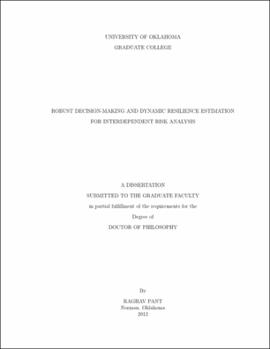| dc.description.abstract | When systems and subsystems are put under external shocks and duress, they suffer physical and economic collapse. The ability of the system components to recover and operate at new stable production levels characterizes resilience. This research addresses the problem of estimating, quantifying and planning for resilience in interdependent systems, where interconnectedness adds to problem complexity. Interdependence drives the behavior of sectors before and after disruptions. Among other approaches this study concentrates on economic interdependence because it provides insights into other levels of interdependence. For sectors the normalized losses in economic outputs and demands are suitable metrics for measuring interdependent risk. As such the inoperability input-output model enterprise is employed and expanded in this study to provide a useful tool for measuring the cascading effects of disruptions across large-scale interdependent infrastructure systems. This research defines economic resilience for interdependent infrastructures as an "ability exhibited by such systems that allows them to recover productivity after a disruptive event in a desired time and/or with an acceptable cost". Through the dynamic interdependent risk model resilience for a disrupted infrastructure is quantified in terms of its average system functionality, maximum loss in functionality and the time to recovery, which make up a resilience estimation decision-space. Estimating such a decision-space through the dynamic model depends upon the estimation of the rate parameter in the model. This research proposes a new approach, based on dynamic data assimilation methods, for estimating the rate parameter and strengthening post-disaster resilience of economic systems. The solution to the data assimilation problem generates estimates for the rate of resilient recovery that reflects planning considerations interpreted as commodity substitutions, inventory management and incorporating redundancies. The research also presents a robust optimization based risk management approach for strengthening interdependent static resilience estimation. There is a paucity of research dealing with quantification and assessment of uncertainties in interdependency models. The focus here is more on the extreme bounds of event and data uncertainties. The deterministic optimization becomes a robust optimization problem when extremes of uncertainties are considered. Computationally tractable robust counterparts to nominal problems are presented here. Also presented in this research is a discrete event simulation based queuing model for studying multi-modal transportation systems with particular focus on inland waterway ports. Such models are used for impact analysis studies of inland port disruptions. They can be integrated with the resilience planning methodologies to develop a framework for large-scale interdependent risk and recovery analysis. | |
